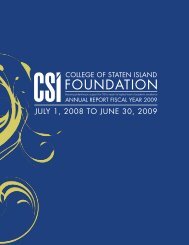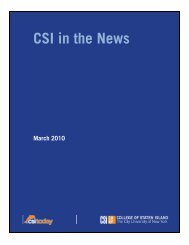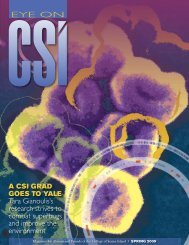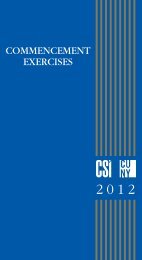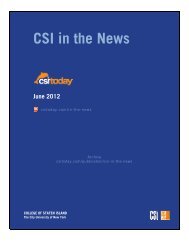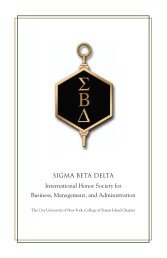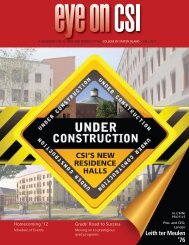csi undergraduate conference on research, scholarship ... - CSI Today
csi undergraduate conference on research, scholarship ... - CSI Today
csi undergraduate conference on research, scholarship ... - CSI Today
You also want an ePaper? Increase the reach of your titles
YUMPU automatically turns print PDFs into web optimized ePapers that Google loves.
Research Poster Presentati<strong>on</strong>sP O S T E R 7 4An Analytical Study of QuantifierComprehensi<strong>on</strong> with EyeTracking DataNicholas Dal<strong>on</strong>zoFaculty Mentor: Dr. Patricia BrooksDepartment of PsychologyGrade-school children often make errors inuniversal quantifier interpretati<strong>on</strong> for sentenceslike Every apple is in a bowl. Whether these errorsare due to children’s unfamiliarity with thecomplexities of sentence structure (faultygrammatical knowledge) or to processinglimitati<strong>on</strong>s (faulty attenti<strong>on</strong> or memory) is notknown. This study seeks to explore the mostcomm<strong>on</strong> sources of children’s errors incomprehending sentences c<strong>on</strong>taining the universalquantifier every. We will also compare thecomprehensi<strong>on</strong> error rates found with passivevoicesentences like The cow was pulled by thehorse with those of sentences c<strong>on</strong>taining universalquantifiers. The experiment presented 23 children(ages 5 to 12) with pictures dem<strong>on</strong>strating aparticular relati<strong>on</strong>ship and asked the children tostate whether a spoken sentence matched thepicture shown. We measured eye-movements as thechild scrutinized the picture and came to ac<strong>on</strong>clusi<strong>on</strong> as to whether the sentence was true orfalse. Half of the quantifiers sentences had theuniversal quantifier modifying the c<strong>on</strong>tainer-noun(e.g., Every bowl has an apple in it) and the otherhalf had it modifying the object-noun (e.g., Everyapple is in a bowl). Half of the time the picturematched the sentence, and half of the time itc<strong>on</strong>tained extra c<strong>on</strong>tainers or objects (e.g., extrabowls for the sentence Every bowl has an apple init). We found that children made numerous errorswhen encountering pictures that depicted sets ofobjects in partial <strong>on</strong>e-to-<strong>on</strong>e corresp<strong>on</strong>dence, al<strong>on</strong>gwith a sentence c<strong>on</strong>taining the quantifier every.This trend was more pr<strong>on</strong>ounced in the 5 to 9 agegrouping, denoting developmental differencesam<strong>on</strong>gst our examined populati<strong>on</strong>. Additi<strong>on</strong>ally,children also made errors with the passivesentences which suggests a general difficulty inassigning syntactic representati<strong>on</strong>s to sentences.P O S T E R 7 5Effects of Curcumin <strong>on</strong>Tau-Interacti<strong>on</strong>s in TransgenicDrosophila Melanogaster MotorNeur<strong>on</strong> and EyeKalpita Abhyankar, Tanya NelipaFaculty Mentor: Dr. Alejandra Al<strong>on</strong>soDepartment of BiologyIt is pivotal to understand the mechanistic functi<strong>on</strong>of synaptic breakdown that precedes in cell deathin Alzheimer's disease (AD) and otherneurodegenerative diseases. Accumulati<strong>on</strong> ofhyperphosphorylated tau causes the disrupti<strong>on</strong> ofmicrotubules, which are related to synaptic lossand pathology of Alzheimer's disease. Impairedcognitive functi<strong>on</strong> and pathology of AD iscorrelated with this lesi<strong>on</strong>. We have previouslyshown that the cytosolic Alzheimerhyperphosphorylated tau (AD P-tau) sequestersnormal tau, MAP1A, MAP1B and MAP2, whichresults in the inhibiti<strong>on</strong> of microtubule assemblyand disrupti<strong>on</strong> of microtubules and self assembleinto filaments. We would like to study the effects ofcurcumin, which is an active ingredient in the spiceturmeric, in causing reversal of the effects oftangles formed by hyperphosphorylated tau. Taupromotes the assembly and stabilizes microtubules.Our model of study is the Drosophila which has thetau homolog exhibiting 46% identity with thesequence of human tau protein and has similarfeatures such as microtubule-binding domain.Transgenic flies (Drosophila melanogaster) thatexpress the human tau in different phosphorylatedforms, wild type and mutati<strong>on</strong>s display importantfeatures of the human disorder. The effects ofcurcumin <strong>on</strong> pseudophosphorylated tau <strong>on</strong> thetransgenic Drosophila motor neur<strong>on</strong> and eye willbe explored.61



